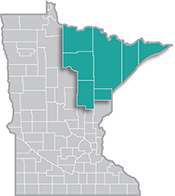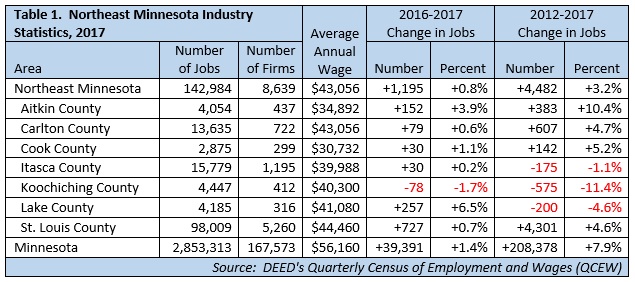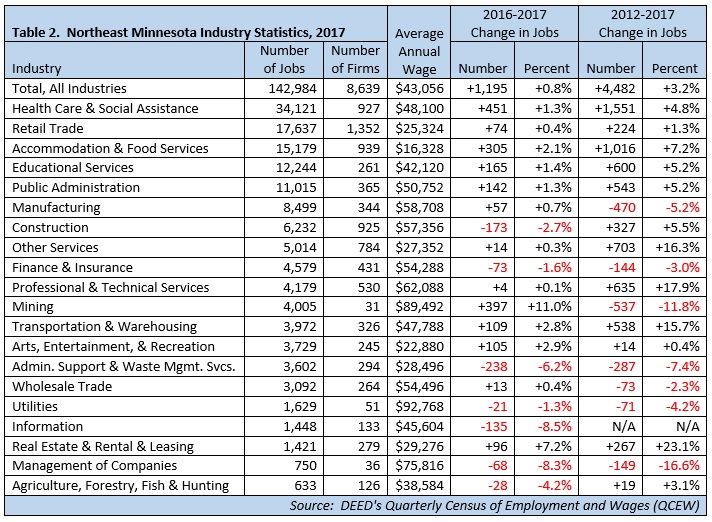 Home to the state's second-largest metro, the Northeast Region has a strong industrial sector, tied largely to the area's abundant natural resources.
Home to the state's second-largest metro, the Northeast Region has a strong industrial sector, tied largely to the area's abundant natural resources.
Most of the manufacturing base centers on mining and forest products industries. More than half of the sector's employment is in paper and machinery manufacturing.
Want the freshest data delivered by email? Subscribe to our regional newsletters.
5/23/2018 12:04:56 PM
Erik White
DEED’s Quarterly Census of Employment and Wages (QCEW) data tool shows a count of jobs and wages by industry as well as by geography, providing great insight into statewide and regional economic trends. Because it’s a census covering all establishments covered under the Unemployment Insurance program, about 97 percent of Minnesota employment is reflected in this dataset. Last month’s release of 2017 annual data from the QCEW show Northeast Minnesota employment growing, though at a slower pace than the state of Minnesota as a whole.
In Northeast Minnesota, there were 142,984 covered jobs supplied by 8,639 employer establishments, with an average annual wage of $43,056. Over the past year employers in the region grew by 1,195 net new jobs, a 0.8 percent increase; the region added 4,482 jobs since 2012, a 3.2 percent increase. These gains, however, do not match the rate of employment growth that the state of Minnesota has had. Employers statewide have expanded by 1.4 percent in the past year with an addition of nearly 40,000 jobs, and have added 208,378 jobs since 2012, a remarkable 7.9 percent growth rate. Also note that the average annual wage statewide is $56,160, over $13,000 more than the average annual wage for jobs in Northeast Minnesota.
A the county level, QCEW data show that six out of seven counties in the Arrowhead region experienced employment increases over the past year, with only Koochiching County recording an employment decrease with a loss of 78 jobs. Lake County gained 257 jobs in the past year, but still had 200 less jobs than it did in 2012. Other counties that had employment losses in the past five years include Itasca and Koochiching with 175 and 575 jobs lost, respectively. In contrast, St. Louis County gained 4,301 jobs in the past five years, a 4.6 percent increase, accounting for most of the region’s recent growth. Aitkin, Carlton, and Cook counties also had job growth over the past five years (Table 1).

Another way to utilize QCEW data is through industry-specific employment and wage details. In Northeast Minnesota, Health Care and Social Assistance is the dominant industry with 34,121 employees and an average annual wage of $48,100. The next leading industries were Retail Trade and Accommodation and Food Services with average annual employment of $17,637 and $15,179, respectively. However, with average annual wages of $25,324 and $16,328, these industries are considerably lower paying. Rounding out the top five industries of employment in the Arrowhead region is Educational Services with 12,244 jobs and Public Administration with 11,015 jobs (Table 2).
Fourteen of the 20 industries in Northeast Minnesota recorded year-over-year job gains, led by Health Care and Social Assistance. Mining added nearly 400 jobs, signifying a rebound but not full recovery as it is still down 537 jobs from 2012 employment levels. Accommodation and Food Services added 305 jobs in the past year and more than 1,000 jobs in the past five years, showing the importance of tourism to the region’s economy (Table 2).

Contact Erik White at 218-302-8413.